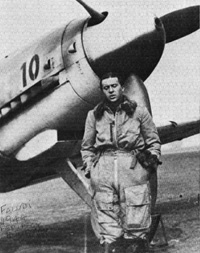This site is best
viewed at 800x600
and 16 bit color.
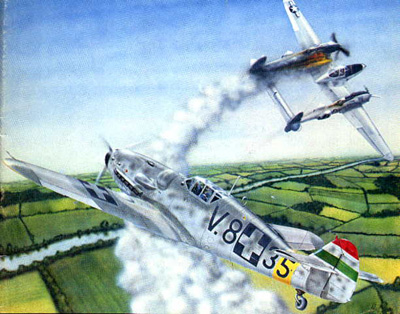 Painting by Robert Karr: | Ambush A Puma Pilot's Revenge by Steve Blake |
| By July 7, 1944, the USAAF’s 82nd Fighter Group was well into the eighteenth month of its long combat tour in the Mediterranean Theater of Operations. The unit had left the U.S. back in September 1942 for the British Isles. Then in late December the pilots had flown their P-38s from England to North Africa, where they were soon embroiled in a hard-fought air war. By the end of 1943 the original pilots had long since finished their fifty-mission combat tours and returned home – at least those who weren’t dead or prisoners of war - but there had been a steady flow of replacement pilots. Since January the 82nd Group had been based at Vincenzo (Foggia #11), one of the large complex of Allied airfields in the Foggia area of southern Italy. The purpose of the July 7 mission, the 82nd’s 723rd, was "To provide withdrawal escort from Banovce, Czechoslovakia, for B-24’s of the 55th and 304th Wings, attacking synthetic oil refineries at Blechhammer and Odertal, Germany". Since the unit’s transfer from the 12th to the new 15th Air Force in November 1943, its main task was the protection of the heavy bombers of the 15th as they attacked strategic targets in southern and Eastern Europe. By 0905 hours on July 7, 38 P-38s of the 82nd FG had taken off from Vincenzo and were enroute to their appointment with the B-24s just north of the Czechoslovakian-Hungarian border 2+ hours away. Making up the formation were 15 Lightnings of the group's 95th Fighter Squadron, 13 from the 96th and 10 from the 97th. Over-all leader was 1st Lt. Joseph F. Belton, an experienced fighter pilot with two confirmed victories to his credit. Belton was at the head of his lead 95th Sq., with the 96th to his right and the 97th to his left. |
Senior Corporal Karoly Faludi of the Royal Hungarian Air Force's 2/1 Fighter Squadron. This photo was taken at Ferihegy Airfield near Budapest in March, 1944. Faludi was shot down and seriously wounded while flying this Me-109G-6 on April 13, 1944 - by P-38s of the 95th Squadron, 82nd Fighter Group. |
| The route this day would take the 82nd FG formation over the Adriatic Sea, Yugoslavia and thence to Hungary, one of Germany’s allies in Eastern Europe. The first serious encounter with e/a over Hungary had taken place on March 17, 1944 and the first actual bombing mission there was on April 2. Since then, a series of air battles had ensued, with heavy losses on both sides. Although a number of single and twin-engined Axis fighter units were involved - both German and Hungarian - the 15th AF’s toughest aerial opponents there were the Me-109 pilots of the Royal Hungarian Air Force’s 101st Fighter Group - the "Pumas". The 101st, with three 16-plane squadrons, was quite similar in size and organization to a USAAF fighter group. It was based outside Veszprem, near the northeast tip of Lake Balaton. |
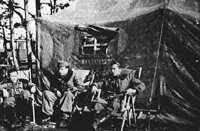 Pilots of 101/1 Sq. at readiness, Veszprem, July, 1944. left to right: Sen. Corp. Pal Szikora (5.5 victories, by the end of the war), Sen. Corp. Faludi, and (?) Skulka, who was KIA shortly thereafter. | One of the Puma pilots who was to see action this day was Senior Corporal Karoly Faludi. Faludi had begun civilian flight training in early 1941, shortly after his 18th birthday, and later that year he was accepted by the Air Force, receiving his wings in late 1942. Around December of that year he was assigned to the 5/1 Fighter Squadron at Matyasfold, near Budapest, with which he flew the "Heja", a Hungarian version of the Italian Re 2000. In the fall of 1943 he joined the 2/1 Sq. at Ferihegy, a few miles south of Matyasfold, under the command of Capt. Miklos Scholtz. During January the squadron began receiving Me-109Gs, on which the pilots trained themselves. On March 17 Faludi flew his first actual combat mission and then on April 13 was shot down by P-38s. Managing to bail out after suffering a serious leg wound, he was confined to hospital for the next two months. Even though his leg was far from healed, Faludi managed to return to his unit; he was back in the cockpit of an Me-109 on June 25 and in combat the following day! By this time 2/1 Sq. had become the 1st Sq. of the new 101st Fighter Group (101/1), which had come into being at the end of May and was based at Veszprem. On July 2, during a huge air battle south of Budapest, Sen. Corp. Faludi scored his first victory, shooting down a B-24. Thus, by July 7 he was a combat-hardened veteran. |
| The pilots of the Puma Group were billeted at Balaton Almadi, on the shore of beautiful Lake Balaton, a few miles south of Veszprem. There they were able to sleep relatively undisturbed by the frequent British flight bombing of their base. On July 7, as usual, the pilots were driven back to Veszprem early in the morning. Breakfast followed, after which some of them napped while others sat around shooting the breeze. On this day Faludi was assigned as wingman to the Group Commander, Lt. Col. Heppes. Thus, he walked over to the Group Headquarters with his gear; his Me-109 was already there. Faludi’s 1st Sq. area was just north of the Hdqts. in a forest bordering the east side of the runway. The 2nd Sq. was just south of tile Hdqts. and the 3rd Sq. was in another forest on the opposite side of the field. Throughout these areas the aircraft were dispersed in U-shaped revetments among the trees to protect them from the bombing. Loudspeakers were set up in the trees so that the pilots could be notified immediately of developing raids. These were connected to the air controllers, based in a cave deep in a mountainside near Budapest, who coordinated the visual reports of trained observers and the radar sightings. |
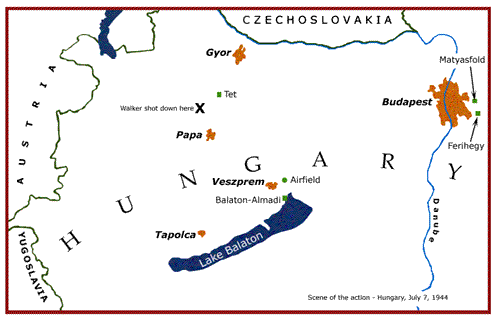 |
| The pilots could thus hear this day’s raid developing: The American bombers were to the west, heading north towards the Czech border. This area was primarily the responsibility of the Luftwaffe. Too, the relatively small numbers of the Pumas necessitated a cautious approach to interception. Better to attack the bombers on their way back, when their formations would be scattered by AA and previous fighter attacks and there will be stragglers which can be picked off. The Hungarian pilots had three stages of alerts. The first stage began when the enemy was forming up over the Adriatic; the pilots then had to be in the vicinity of the airfield. Stage two began when the Americans crossed Hungary’s borders; they were then on 15 minutes notice. At the third stage the pilots were in their planes ready to scramble as ordered. |
| One of the Puma squadrons was already in action with the Germans near Gyor. About the time it was expected to return there was an alarm and Col. Heppes led ten Me-109s aloft and headed north. When the formation arrived near Gyor the enemy which had been encountered there a few minutes before were nowhere to be seen. After circling for ten to fifteen minutes, the 109 pilots were ordered by the controllers to fly south, toward Papa. About 30 miles had been covered when 10 P-38s were spotted near Tet; they were at 3 o’clock, about 2000 meters below the Messerschmitts, which were at about 4000 meters (13,000 ft.). "Old Puma" (Heppes) gave the order to attack but forbade individual dogfights. The Hungarians made a diving turn to the right, coming down on the Lightnings at a 30° angle. The P-38s immediately went into a Lufbery circle. The 82nd F.G. pilots had reached their assigned rendezvous north of Gyor at 1125, altitude 23,000-ft. They circled for 20 minutes but nothing was seen of their assigned B-24s, nor could they be contacted by radio – although several B-17 formations flew by. Finally, the P-38s headed south, overtaking an unidentified B-24 formation which was being covered by some P-51s. Me-109s were then engaged at about 1150 hours. | 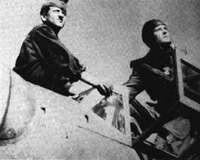 2nd Lt. Lajos Toth (in cockpit). Toth's P-38 claim on July 7 was his seventh victory, four of which he had claimed in Russia with the 5/2 Sq. He had previously claimed a P-47 on June 16 and a B-17 on June 27; his eigth victory was a B-24 on November 5, 1944. Thereafter he scored 13 more kills against the Russians for a total of 21. |
| The enemy were first spotted at low altitude a reported 70 miles north of Lake Balaton. The second section of the 96th Sq. went down to intercept four 109s heading north. These P-38s were in turn jumped by six or seven more 109s which made one pass. The 96th’s first section came down to join the fight and in the ensuing action two of the Me-109s were claimed destroyed by this squadron – one by 1st Lt. Merrill M. Adelson (his 3rd victory) and the other by 1st Lt. Walter J. Carroll (his 4th). Carroll, leader of the 96th’s fourth flight, in the process collected some bullet holes in the left wing and wheel door of his P-38. The 95th Sq. also entered the fray, its second section pursuing two 109s which dived away from some P-51s high above the Liberators. These Lightnings were in turn jumped by a reported six to eight more Messerschmitts, whereupon the first section of the 95th waded in. Three more 109s were claimed by the 95th Sq. - one each by Lt. Belton, 1st Lt. Jack D. Joley, leader of the second flight (his 3rd victory) and 2nd Lt. James C. Hardin. This was Hardin’s first victory; he had joined the squadron less than two weeks before, on June 26. Interestingly, Belton’s was the 500th confirmed aerial victory for the 82nd FG. |
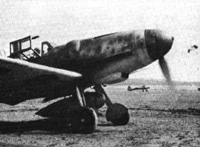 An Me-109 of the Pumas preparing to take off from the base at Veszprem, 1944. Notice the Hungarian Me-210 in the background; these suffered heavy losses to USAAF fighters during that spring. | All this was not without loss; 22-year old 2nd Lt. Charles C. Walker was MIA. Walker had been flying as wingman to the leader of the 95th’s fourth flight, 1st Lt. Roy I. Harman; he had been assigned to the squadron just ten days before, on June 27. 2nd Lt. Lester J. Henry who had joined the 95th on the same day as Hardin - received minor damage to his P-38 in the form of a high-explosive bullet in his left wheel door. Like Lt. Carroll of the 96th, Henry was able to return to base safely The 97th Sq. had stayed up high with the bombers and did not become involved in the dogfights below. There had suddenly been more P-38s than the Pumas could handle; some of the Americans’ buddies had come down to assist their beleaguered comrades. Faludi saw Col. Heppes shooting into the P-38 Lufbery, then suddenly a large form interjected itself between the two 109s. This P-38 was about 300 meters ahead and right in Faludi’s gunsight; he gave the Lightning a long 5 or 6-second burst from his two 13mm machine guns to get him off Heppes’ tail. Faludi saw strikes on the P-38, which he now believes to have been Lt. Carroll’s. At the same time, however, bullets flew perilously close by Faludi’s own cockpit and he quickly dived away to his right to escape this fusillade. |
| Shortly thereafter, as he climbed up to rejoin his flight, Faludi saw a lone P-38 a mile ahead of and about 1000 meters below him, barreling along at full speed. The reason for the American’s haste soon became apparent - there were three 109’s at his heels ¼ to ½ mile behind! The latter were led by 1st Lt. Pal Iranyi, of Faludi’s 101/1 Sq. On the spur of the moment, Faludi decided to go after this P-38 himself. He immediately went into a steep dive, then pulled up, his superior speed from the dive enabling him to out-distance the other Messerschmitts and pull within 100 meters of the belly of the P-38. The enemy pilot was evidently watching the other 109s and had no idea that there was a fourth in the blind spot below his tail. Faludi moved his plane closer and closer to the P-38. Suddenly the Lightning banked to the left and then to the right; perhaps its pilot sensed that he was not alone Faludi was able to duplicate these maneuvers in precise unison, thereby remaining invisible to the enemy pilot. He then came up directly behind the P-38 at a range of about 50 yards, opening up with the two machine guns and single 20mm cannon in the nose of his Me-109. The bullets scored immediately and devastatingly in the area of the left engine and the adjacent inboard wing area containing one of the fuel tanks. There were simultaneous explosions, flame and a huge trail of white smoke. The P-38 made a quick turn to the right and then the pilot bailed out from a little over 200 meters. Faludi circled the American’s parachute, saw him land and then spotted a military vehicle speeding toward him. All alone now, Faludi returned to Veszprem. |
| Another Puma pilot, 2nd Lt. Lajos Toth, who had become separated from his flight, had a spirited dogfight with another 82nd FG P-38 (possibly Lt. Henry), resulting in damage to both planes. As he put a burst into his opponent, Toth was attacked from above by other Lightnings and driven down. His engine was hit and burst into flames, whereupon Toth pulled his Me-109 up into a stall and bailed out. By an interesting coincidence, the pilot of Faludi’s P-38, Lt. Walker, came down in the same area and both were picked up and taken to the airfield at Papa. Toth quite naturally assumed that the American flier was the pilot of the P-38 he had hit. Toth and Walker talked together in a friendly manner and had their picture taken together, shaking hands, better the latter was taken away to be interrogated. | 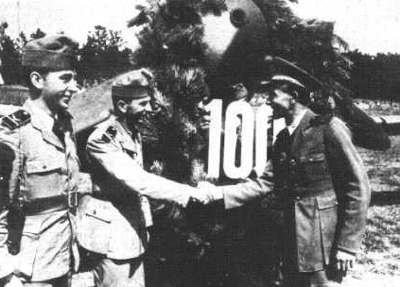 Col. Heppes congratulates the squadron commanders of hte 101st F.G. on the destruction of 100 American aircraft over Hungary - September 1944. At the extreme left (face only) is 1st Lt. Pal Iranyi, by then C.O. of the 1st Sq; on July 7 he had been a flight leader. Iranyi had a total of 3.5 victories during the war. |
| A total of three P-38s were claimed as destroyed by the Pumas on July 7; although three were, in fact, hit (Carroll, Henry and Walker), only Walker was actually shot down. Faludi initially was given credit for the first P-38 he had hit and Toth for Walker. Later Faludi was credited with yet another Lightning that day, since both Col. Heppes and Lt. Iranyi had seen him shoot down this plane (which turned out to be Walker’s). The "Old Puma" had, in fact, been heard to congratulate Sen. Corp. Faludi over the radio when he saw Faludi’s target (Walker's P-38) crash. Unfortunately, in the heat of the fight no one remembered the exact map square, thus Col. Heppes had noted the wrong sector for Faludi’s second victim, which confused the issue even further. Despite a careful search, the wreckage of only one P-38 was found, Lt. Walker’s P-38J-15, serial #44-23189. Of course, Toth had claimed this one, in the proper sector! Judging from the available statements from two of the pilots in Walker’s squadron that day - Belton (squadron and group leader) and 2nd Lt. Gerard F. Cavanaugh (leader of the second element in Harman’s flight) – there was considerable confusion as to what happened to Walker. | 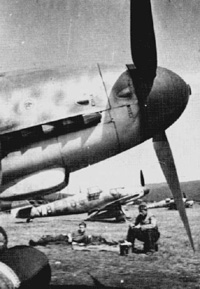 Me-109Gs and groundcrewmen of the 101st Fighter Group at Veszprem, 1944. Note the small Puma insignia above the exhaust stacks in foreground. |
| Belton: "While leading the squadron on return from north of the Danube, enemy fighters were seen above the bomber formation engaged by P-51s. Some E/A were driven down to our level, and the last flight, in which Lt. Walker flew #2 position, followed a Me-109 down to the deck. A few minutes later, I heard them calling for assistance and went back to help them. Before reaching them, I heard Lt. Walker call and say he was on single engine and needed help badly. We could not locate him and he was not heard again." Cavanaugh. "I was flying #3 man in the flight in which Lt. Walker was #2 man. The flight had gone down to chase a Me-109 and the enemy airplane led us straight across an airdrome near Gyor, Hungary. Accurate light and heavy flak was thrown up at us from this A/D, which we crossed at about 400 ft. altitude. I saw smoke come from Lt. Walker’s left engine, but lost him momentarily while looking around for other enemy planes. When I looked ahead again, I was flying on the flight leader’s wing and Lt. Walker was nowhere in sight." |
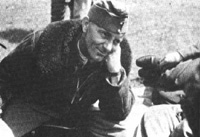 Lt. Col. Aladar Heppes, C.O. of the 101st F.G. Heppes was almost certainly the oldest fighter pilot to become an ace for the first time, a status he achieved on June 26, 1944, when he shot down two B-24s. Reprtedly born in 1900, he was at least 43 years old at the time! Heppes had been a member of the original "Puma" Sq. (1/3) back in 1937 and had designed its famous puma head insignia. He took command of the squadron the following year and it later became the new 2/2 Sq. When Heppes formed the 5/1 Fighter Group in December 1942, he adopted the name and insignia of the Puma Sq. since so many of the new group's pilots had flown with the latter. The same was true later with the establishment of the 101st Group and Regiment. Heppes had scored four kills in Russia with the 5/1 Group. On July 2, 1944 he shot down a B-17 and on July 7 claimed a B-24 for his eigth and final victory. | It is obvious from the above statements that no one on the American side actually saw Walker being hit or bailing out. It seems to have been assumed that Walker was hit by AA fire, as Lt. Walker himself very likely did before bailing out. Reportedly, Capt. Gyorgy Debrody of the 101/3 Sq. also damaged a P-38 on this date. Debrody also claimed a B-17 destroyed, the 22nd of his eventual 26 victories. In addition to the three P-38s, the Hungarian fighter pilots were credited with six B-24s and two B-17s on July 7. Actual, total 15th AF losses that day amounted to a P-38 (Lt. Walker’s), two P-51s, seven B-17s and fifteen B-24s. The P-38 and two B-24s were reportedly lost over Hungary, while seven B-24s and six B-17s went down over Germany, five B-24s over Yugoslavia, one P-51 over Poland and the other P-51 over Czechoslovakia. The remaining B-17 and B-24 were lost over Austria and Italy, respectively. It could very well be that some of the Liberators which crashed in Yugoslavia were victims of the Hungarians. Claims by other 15th AF fighter groups totaled seven, all by P-51s: three by the 52nd P-51, two by the 31st FG and two more by the 325th FG. Actual Axis losses are unknown, although out of Heppes’ ten-plane flight only Toth was shot down. There were, of course, other Axis units active in the general area that day. Many months later, Faludi met the Hungarian army captain who had captured Lt. Walker. The captain told Faludi all that he remembered about the American, including his full name. Faludi was startled to learn that he and Walker shared the same first name - Karoly is the Hungarian equivalent of Charles. "Charlie" Faludi had reason to recall all this information nearly forty years later. |
| The 82nd FG continued its fight against the Axis for ten more long months. On July 8, during a fighter sweep to Vienna, the group destroyed 22 more enemy planes, Lt. Carroll shooting down three Me-410s to bring his score to seven. On July 26, during a fighter sweep over Ploesti, Rumania, en route home from a shuttle mission to Russia, he downed a Fw-190, his eighth and final victory. Lt. Henry, unfortunately, was lost during a bomber escort mission to northern Italy on July 13. His plane was hit by AA, but ho was seen to bail out successfully. The 82nd FG was at this time the top-scoring USAAF fighter group in the MTO, a position it had held for many months. By early August its score had reached 550, but the group’s opportunities to engage enemy planes in the air dwindled thereafter to almost nil. The 82nd added just four more victories by VE Day and was finally surpassed by the 31st FG on March 31, 1945. |
| The Pumas continued their fight as well. By September the intense Allied bombing of Hungary had pretty much ceased; there would be only isolated raids by the western Allies thereafter. Thus, the Pumas turned their attention back towards the east to the invading Russians and their Soviet Air Force. Up to the end of August the Hungarian fighter pilots had claimed at least 116 American aircraft, of which 88 were confirmed, but thereafter claimed only 19 more (13 confirmed). In September the Pumas were enlarged, becoming the 101st Fighter Regiment composed of two three-squadron groups, 101/I and 101/II. A third group was added in January 1945. The vast majority of all Hungarian fighter claims - including eight in the brief war with Slovakia in 1939 and 398 against the Russians in WWII - were made by the various Puma squadrons, groups and regiment. Karoly Faludi’s personal involvement in the war continued unabated, also. From mid-July on his main duties were ferrying and test piloting. Faludi was still barely able to walk; he was supposed to have been hospitalized for a full year as a result of his Leg injury! Nevertheless, he still flew occasional combat missions and scored one more victory in December 1944. | 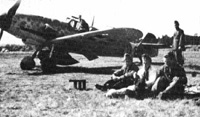 Me-109G and 101st Fighter Group personnel at Veszprem in mid-1944. |
| In March 1945 Faludi and the remnants of the Pumas retreated to southern Germany when the Russians finally over-ran Hungary. He was fortunate to be in the western Allied sector of the front after the war’s end, and later he and his new bride (Rose, the sister of his best friend and fellow 101/1 Sq. pilot Jozsef Nagy) emigrated to the U.S. Now known as Charles K. "Charlie" Faludi, he lives in southern California and works for Northrop Aviation. Interestingly, several years ago he discovered that a fellow employee, Leon Scrydloff, had been a USAAF tighter pilot in WW2. Further investigation revealed the startling information that then 2nd Lt. Scrydloff was one of the ten 97th FS pilots covering the B-24s on the July 7, 1944 mission! |
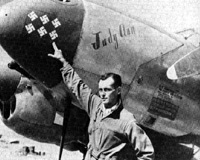 Another of the American pilots on the July 7, 1944 mission was 1st Lt. Charles E. Adams, who led the 95th Squadron's third flight. On the following day, July 8, Adams shot down three Me-410s near Vienna, becoming an ace with six victories. He was photographed a short while later with his P-38J-15, serial #43-28796. (Adams photo.) | Additional research has brought another interesting coincidence to light. On the day Sen. Corp. Faludi was shot down and wounded - April 13, 1944 - there were fifteen claims by 15th AF P-38s, five by the 1st FG and ten by the 82nd. Based on the available records, Charlie is convinced that it was the 82nd Group which he encountered on that occasion. Only two of the 82nd’s claims on April 13 were for Me-109s - one each by 1st Lt. Orson D. Osborne and 2nd Lt. Melvin E. Wiedbusch of the 95th FS. Thus, it is almost certain that the P-38 Faludi shot down on July 7 was from the same squadron which shot him down on April 13! (My sincere thanks to Mr. Faludi for his invaluable input; without it, of course, this article would have been impossible. All but one of the photos illustrating the article are from his private collection.) |
